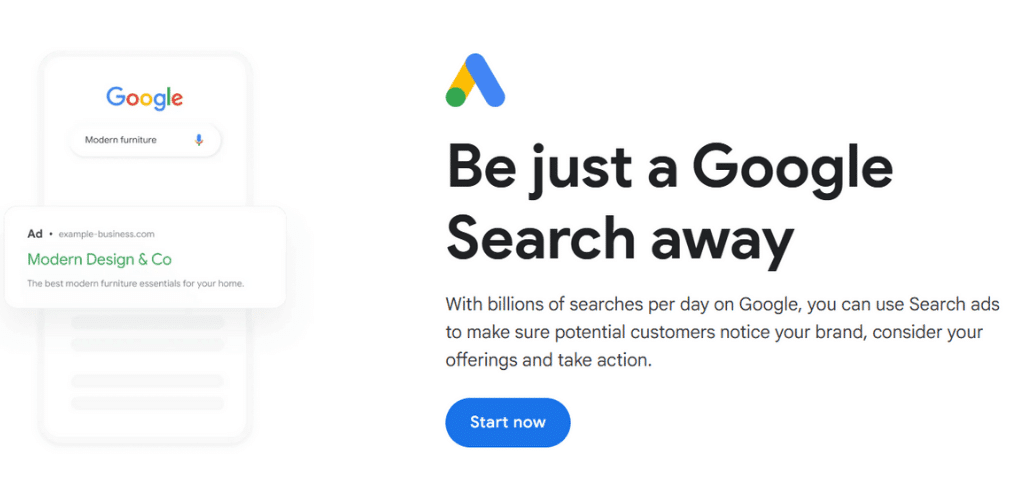Are you struggling to make your business stand out in the crowded digital landscape? Google Search Ads might be the game-changer you’ve been looking for. In today’s fast-paced online world, visibility is everything, and Google’s powerful advertising platform can put your products or services right in front of potential customers when they’re actively searching.
Imagine having the ability to reach your target audience at the exact moment they’re looking for what you offer. That’s the power of Google Search Ads. Whether you’re a small local business or a large corporation, this versatile tool can help you boost your online presence, drive traffic to your website, and ultimately increase your bottom line. But where do you start? How do you create effective ads that capture attention and drive results?
In this comprehensive guide, we’ll walk you through everything you need to know about Google Search Ads. From setting up your account to optimizing your campaigns for maximum ROI, we’ve got you covered. You’ll learn how to craft compelling ad copy, choose the right keywords, and leverage advanced features to outshine your competition. So, are you ready to take your digital marketing to the next level? Let’s dive in and discover how Google Search Ads can transform your online visibility and drive your business forward.
Table of Contents
Understanding Google Search Ads
What is Google Search Ads
Google Search Ads are keyword-driven pay-per-click (PPC) advertisements that appear on search engine results pages (SERPs). You can use these ads to capture user intent, presenting your offerings to individuals actively searching for specific products or services. With Google Search Ads, you gain immediate visibility to a targeted audience and enjoy budget flexibility.
How They Differ from Organic Search Results
| Feature | Google Search Ads | Organic Search Results |
|---|---|---|
| Placement | Top or bottom of SERP | Below ads on SERP |
| Cost | Pay-per-click | Free |
| Visibility | Immediate | Takes time to rank |
| Control | High control over content | Limited control |
Benefits for Businesses
- Targeted reach to active searchers
- Flexible budgeting options
- Measurable ROI
- Ability to drive both online and offline results
Now that you understand Google Search Ads, let’s move on to setting up your Google Ads account to start leveraging these benefits for your business.
Setting Up Your Google Ads Account

Now that we’ve covered the basics of Google Search Ads, let’s dive into setting up your Google Ads account. You’ll start by creating your account on ads.google.com. It’s recommended to choose “Expert Mode” for greater control over your ad management. Remember, preparing your website with relevant, easy-to-navigate landing pages is crucial before you begin.
Creating a Google Ads Account
- Sign in with your Google account
- Navigate to ads.google.com
- Choose “Expert Mode”
- Enter your business information
- Link existing accounts (e.g., YouTube, Google Business Profile)
Navigating the Google Ads Interface
| Feature | Description |
|---|---|
| Campaign Manager | Create and manage ad campaigns |
| Keyword Planner | Research and select keywords |
| Analytics | Track ad performance and ROI |
How To Create Google Search Ads
Now that you’ve set up your Google Ads account, it’s time to create your first search ad campaign. You’ll start by choosing the right keywords that align with your campaign goals. Remember, these keywords should be relevant to your product or service and match what your potential customers are searching for.
A. Choosing the right keywords
When selecting keywords, consider:
- Relevance to your business
- Search volume
- Competition level
| Keyword Type | Description | Example |
|---|---|---|
| Broad Match | Reaches widest audience | shoes |
| Phrase Match | More targeted | “running shoes” |
| Exact Match | Most specific | [red running shoes] |
B. Writing compelling ad copy
Your ad copy should:
- Include your chosen keywords
- Highlight unique selling points
- Use strong calls-to-action (CTAs)
Google Search Ads Examples
Now that we’ve covered how to create Google Search Ads, let’s explore some examples to inspire your campaigns. You’ll find various ad formats that can enhance your online visibility and engage potential customers effectively.
A. Text ads
Text ads are the foundation of Google Search Ads. You can create compelling messages using only words, making them easy to maintain and effective in reaching customers during their searches. To maximize impact, consider incorporating ad assets to enhance relevance.
B. Responsive search ads
Responsive search ads offer flexibility by dynamically adjusting to fit different ad spaces. You can input multiple headlines and descriptions, allowing Google to test various combinations for optimal performance. This format helps you reach more potential customers with tailored messages.
C. Call extensions
| Extension Type | Purpose |
|---|---|
| Call | Enable direct phone calls from ads |
Call extensions allow you to add a clickable phone number to your ads, making it easy for potential customers to contact you directly. This feature is particularly useful for businesses that prioritize phone inquiries.
D. Sitelink extensions
Sitelink extensions provide additional links beneath your main ad, acting as mini-ads that direct users to specific pages on your website. You can use these to highlight key products, services, or promotions, improving navigation and user experience.
E. Callout extensions
Callout extensions offer brief snippets of text to emphasize unique selling points or special offers. You can use these to highlight key features, guarantees, or time-sensitive promotions, making your ads more compelling and informative.
With these examples in mind, next, we’ll explore how to optimize your Google Search Ads for even better performance and ROI.
Optimizing Your Google Search Ads
Now that we’ve explored some Google Search Ads examples, let’s dive into optimizing your campaigns for better performance.
A. Monitoring performance metrics
You should regularly assess key metrics such as click-through rates, conversion rates, and cost-per-conversion. By analyzing these data points, you can identify areas for improvement and make data-driven decisions to enhance your ad performance.
B. A/B testing ad variations
To refine your ad strategy, conduct A/B tests on different ad elements:
- Headlines
- Descriptions
- Call-to-actions
- Ad extensions
| Element | Variation A | Variation B |
|---|---|---|
| Headline | “Save 50% Today” | “Limited Time Offer” |
| CTA | “Shop Now” | “Get Your Discount” |
With this approach, you’ll discover which combinations resonate best with your audience, leading to improved ad effectiveness.
Google Search Ads Best Practices
Now that we’ve covered optimizing your Google Search Ads, let’s explore some best practices to elevate your campaign performance.
Remarketing campaigns
You can leverage remarketing to re-engage users who have previously interacted with your website. This strategy allows you to create tailored ads for specific audience segments, increasing the likelihood of conversion.
Dynamic search ads
| Feature | Benefit |
|---|---|
| Automated targeting | Saves time |
| Real-time relevance | Improves ad performance |
| Fills keyword gaps | Captures missed opportunities |
Dynamic search ads automatically target relevant searches based on your website content, helping you capture traffic you might have missed with traditional keyword targeting.
Measuring Success and ROI
Now that we’ve covered Google Search Ads best practices, let’s dive into measuring the success and return on investment (ROI) of your campaigns. Understanding these metrics is crucial for optimizing your advertising efforts and maximizing your results.
Key performance indicators (KPIs)
To evaluate the effectiveness of your Google Search Ads, you’ll need to focus on key performance indicators. Here are some essential KPIs to track:
- Return on Investment (ROI)
- Return on Ad Spend (ROAS)
- Conversion Rate
- Cost per Conversion
| Metric | Description | Good Benchmark |
|---|---|---|
| ROI | Net profit / Total costs | 3:1 or higher |
| ROAS | Revenue from ads / Ad spend | 4:1 or higher |
Google Search Ads offer a powerful way to boost your online visibility and drive targeted traffic to your business. By understanding the fundamentals of this platform, setting up your account correctly, and creating compelling ads, you can effectively reach potential customers at the moment they’re searching for your products or services.
Remember to continually optimize your campaigns by following best practices, monitoring key performance metrics, and measuring your return on investment. With Google Search Ads, you have the tools to refine your targeting, adjust your bidding strategies, and improve your ad copy to maximize results. By leveraging this platform’s capabilities, you can stay ahead of the competition and achieve your marketing goals. Start implementing these strategies today and watch your online presence grow.







